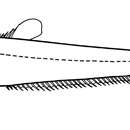Diagnostic Description
provided by Fishbase
Tail slender and tapering to a point. Mouth inferior, small and sucker-like; upper lip with thick, pleated folds; posterior end of maxilla bent sharply downward, forming a flap-like structure; fleshy papillae on snout bordering upper lip. Teeth absent. Dorsal fin short-based, located above anus, the first 4-6 rays hard and spinous, increasing in length from front to back, the remainder soft and segmented, membrane connecting all rays except for first I-III spines. Anal fin long, extending from just behind anus to tip of tail, anterior rays spinous, posterior rays segmented, the transition gradual. Caudal fin absent (Ref. 11041). Light brown, lining of gill chamber and rim of opercular branchiostegal flap dark brown, mouth and lining of buccal cavity light yellowish tan (Ref. 37108).
- Recorder
- Crispina B. Binohlan
Life Cycle
provided by Fishbase
Sexes can be separated by testis and ovaries; there is no indication of internal fertilization.
Morphology
provided by Fishbase
Dorsal spines (total): 6 - 8; Dorsal soft rays (total): 4 - 5; Anal spines: 44 - 58; Analsoft rays: 67 - 88; Vertebrae: 228 - 234
- Recorder
- Crispina B. Binohlan
Trophic Strategy
provided by Fishbase
Found on the continental slope (Ref. 75154). Feed mostly on organic material contained in bottom sediment drawn up by the sucker-like mouth [RF believes this belongs to soft-bodied invertebrates]. No obvious sexual dimorphism; little is known about its biology (Ref. 11041).
- Recorder
- Drina Sta. Iglesia
Biology
provided by Fishbase
Feed mostly on organic material contained in bottom sediment drawn up by the sucker-like mouth [RF doubts this is a detritus feeder; the elaborate mouth without teeth looks like a specialization for extracting soft-bodied benthic invertebrates out of the ground; also, there are no gill rakers to filter detritus (Ref. 50674)]. No obvious sexual dimorphism; a female of 37.5 cm SL was still immature (Ref. 50674).
- Recorder
- Crispina B. Binohlan
Importance
provided by Fishbase
fisheries: of no interest
- Recorder
- Crispina B. Binohlan
Lipogenys
provided by wikipedia EN
Lipogenys gillii, the blackfin tapirfish, is a species of spiny eel in the family Notacanthidae, the only member of its genus. It is a benthic deep-sea fish occurring along the eastern coast of North America and in the southwestern Pacific near Australia at depths from 400 to 2,000 m.
References

- license
- cc-by-sa-3.0
- copyright
- Wikipedia authors and editors
Lipogenys: Brief Summary
provided by wikipedia EN
Lipogenys gillii, the blackfin tapirfish, is a species of spiny eel in the family Notacanthidae, the only member of its genus. It is a benthic deep-sea fish occurring along the eastern coast of North America and in the southwestern Pacific near Australia at depths from 400 to 2,000 m.
- license
- cc-by-sa-3.0
- copyright
- Wikipedia authors and editors
Diet
provided by World Register of Marine Species
Feeds on organic material
North-West Atlantic Ocean species (NWARMS)
- license
- cc-by-4.0
- copyright
- WoRMS Editorial Board
Distribution
provided by World Register of Marine Species
Nova Scotia and Hudson Canyon
North-West Atlantic Ocean species (NWARMS)
- license
- cc-by-4.0
- copyright
- WoRMS Editorial Board
Habitat
provided by World Register of Marine Species
Found at depths of 600- 2000 m.
North-West Atlantic Ocean species (NWARMS)
- license
- cc-by-4.0
- copyright
- WoRMS Editorial Board
Habitat
provided by World Register of Marine Species
benthic
North-West Atlantic Ocean species (NWARMS)
- license
- cc-by-4.0
- copyright
- WoRMS Editorial Board
Habitat
provided by World Register of Marine Species
Known from seamounts and knolls
Stocks, K. 2009. Seamounts Online: an online information system for seamount biology. Version 2009-1. World Wide Web electronic publication.
- license
- cc-by-4.0
- copyright
- WoRMS Editorial Board

